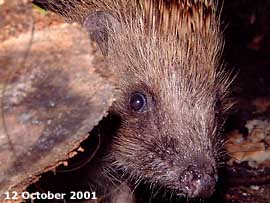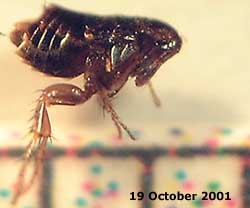Go to last entry........................................Go to previous entry
The wind is encouraging the effects of Autumn as by this afternoon the ground under the Hawthorn was starting to get covered by fallen leaves. The picture shows how some of the leaves on the tree are changing to their rather sorry looking Autumnal colours. The ground under the Birch tree is also becoming covered with fallen leaves, although they are all still green. Looking up towards the local Country Park I see that a couple of the most exposed trees are close to being stripped of their foliage.
Sheltered under the shrubs are quite a few of these fungi. The taller one is about 5cm tall and a cap 2.5cm wide. Click on the picture to see other images. I have put one of the caps on a glass sheet to get a spore pattern. Hopefully I will have something for the diary tomorrow.
In contrast to this, the morning started wet and very gloomy. After The rain stopped I spotted this female cranefly (Tipula spp.) sheltering among leaves. Click on the image to see a closeup that shows one of its halteres, rear wing(s) reduced to balancing devices. We have been seeing a lot of these this year.
As promised yesterday, here is a spore print and microphotograph of spores from the fungus I pictured in yesterday's entry. I have not spent time trying to identify it.
Yesterday's wind has now subsided, leaving most of the leaves still in place on the Birch and the Hawthorn. There were a couple of visits by a Great Tit and I saw a Red Admiral butterfly go to the Ivy briefly.
9 October - This last week has flown by. We have had our first proper Autumn gale and a lot of rain. The ponds have been topped up repeatedly and the ground is sodden. Despite the strong winds there has been very little leaf cover lost since a week ago, although many of the leaves on the Birch are now starting to change colour. Tonight the sky is absolutely clear and I had a very good view of the International Space Station as it passed over us.
Today we had several visits by a Coal Tit. These are the sightings of this little bird in the garden this year. During one visit it was chased off by the robin (who I am now on the point of declaring a resident!). There seem to be more Blue Tit visits and there are often up to six Collared Doves perched somewhere around the garden. The blue line you can see in the Sparrow picture is part of my Autumn/Winter precautions, securing the roof of the caravan shelter during high winds.
It is a female and measures nearly 2cm long (excluding the ovipositor). I cannot be sure of its identification. Although it is similar to Isophya pyrenea, the book illustration shows the lower legs being green, not reddish. I nearly forgot -last Thursday I saw a Hedgehog on the garden for the first time for a long time. It looked large and well fed, but it disappeared in the short time it took me to get my camera.
While watching these I also caught sight of a Long-Tailed tit on my neighbours tree.
Another sighting was very welcome this afternoon. For the first time this year I spotted a Goldcrest hunting among the Leylandii at the bottom of the garden. A regular visitor for a number of years, I thought that we might have lost them. This picture is one I took several years ago (I did not record the date). Click on the image for a larger version.
While I was doing some woodwork in the garden The Sparrows were surprised by a Sparrowhawk visit. I went down on my knees as she (indicated by her large size, brown wing feathers and markings) swooped around me, the Hawthorn and the Berberris in what was an unsuccessful raid.
The spider pictured here was actually spotted last night on a Geranium leaf. Its body is about 7mm long. As usual I am uncertain about its identity but is is very similar to the illustration of Clubiona pallidula in my Larousse Guide to Spiders.
Back on the ground, lifting a house brick revealed this cluster of eggs. Each one is slightle eliptical in shape, measuring 4mm by 3.5mm. They are probably slug eggs as I do not think a snail could have got into the space under the brick.
There were Woodlice, tiny centipedes and this slug sharing the same hiding place under the brick. The slug measures some 17mm in length in the picture and 27mm when fully extended. It looks far too small to be the parent of the eggs. The bluish colouring in the picture is due to the reflection of the sky. It is grey in colour, and the lighter bands at the side have a hint of yellow/orange. It has a pale yellow sole (underside). It is probably a common Garden Slug. I cannot claim it for the garden, but I spent time watching a Great Spotted Woodpecker on one of the trees in the Brickfields Country Park. I can only remember one Woodpecker ever coming into the garden. Also, a pair of Jays flew over. I have seen passing Jays several times over the last couple of weeks. The Coal Tits came this morning, but no sign of the Goldcrest. A male Sparrowhawk visited, failed to catch anything and then perched on a tree for a few minutes. The aroma of the Ivy flowers was strong today but it still only attracted a couple of Red Admirals. I did catch a fleeting glimpse of a smaller brown butterfly.
What I did spot was this Hedgehog which had been taking advantage of some chopped peanuts left by the birds. I shall have to ensure that supplies are left every evening from now on. Click on the image for a larger version.
19 October - Very little seems to have changed in the garden over the last week. The hedgehog pictured above has now become a regular night visitor (usually after 10pm) to the peanuts. The Coal Tits have been here every day since our first sighting, although I have not seen a Goldcrest since I last mentioned them. A couple of Great Tits have been here nearly every day and I am seeing more Blackbird activity in the trees, although I have yet to see them down in the garden. There seem to be two pairs competing for ownership of the local territory. On the insect front, I have been disappointed by the lack of activity I have seen recently, especially around the Ivy, which is still producing its pungent aroma, even though most of the flowers have now opened. I have seen one Red Admiral this week.
I think I could count at least 10 of these bristles on either side and this suggests that it is not a cat or dog flea as my books say that they have eight bristles each side in the pronotal comb. I did pay a visit to the bird box to day so I am wondering whether it could be a bird flea - a bit more research will be needed this weekend. The box was cleaned out a while ago but I may have missed a corner somewhere! |
|
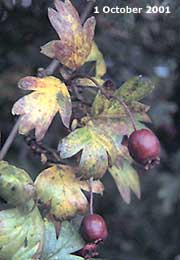 1 October -
A dull and windy start to the month today as the leftovers of
Hurricane Humberto pass to the West of the UK.
1 October -
A dull and windy start to the month today as the leftovers of
Hurricane Humberto pass to the West of the UK.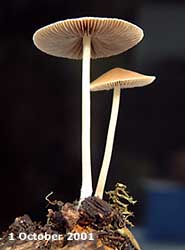
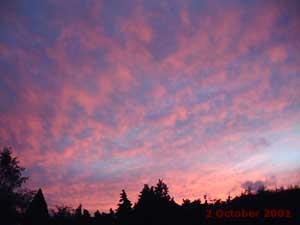 2
October - I'll start
at the end of the day with this view of the sky at sunset, looking
about WSW from our bedroom window.
2
October - I'll start
at the end of the day with this view of the sky at sunset, looking
about WSW from our bedroom window.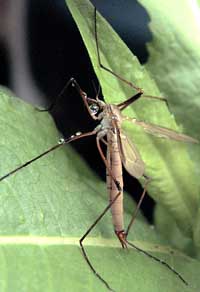
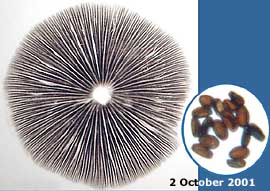
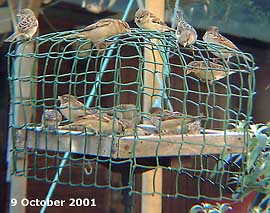
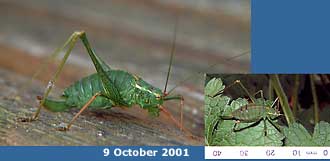
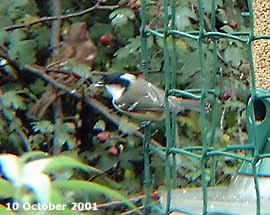 10
October - Yesterday
I mentioned the visits by a Coal Tit. Well, today these have
continued and it turns out that there are two of them - a first
for me in the garden. This snatched image shows one leaving the
feeder. The smallest of the British Tits, the white patch on
the nape of its neck is a characteristic of the Coal Tit.
10
October - Yesterday
I mentioned the visits by a Coal Tit. Well, today these have
continued and it turns out that there are two of them - a first
for me in the garden. This snatched image shows one leaving the
feeder. The smallest of the British Tits, the white patch on
the nape of its neck is a characteristic of the Coal Tit.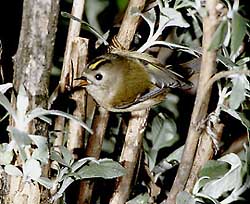
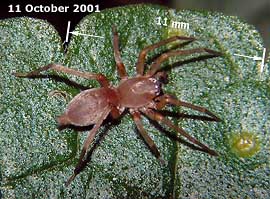
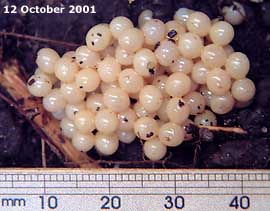 12
October - (entered
am 13 Oct) A Summer's day with temperature up to 21C and hardly
a cloud in the sky all day. I spent all day in the garden, movings
some plants about and starting to trim the top of the Leylandii.
I should have had my camera up there with me when a Heron flew
past low and slow!
12
October - (entered
am 13 Oct) A Summer's day with temperature up to 21C and hardly
a cloud in the sky all day. I spent all day in the garden, movings
some plants about and starting to trim the top of the Leylandii.
I should have had my camera up there with me when a Heron flew
past low and slow!
